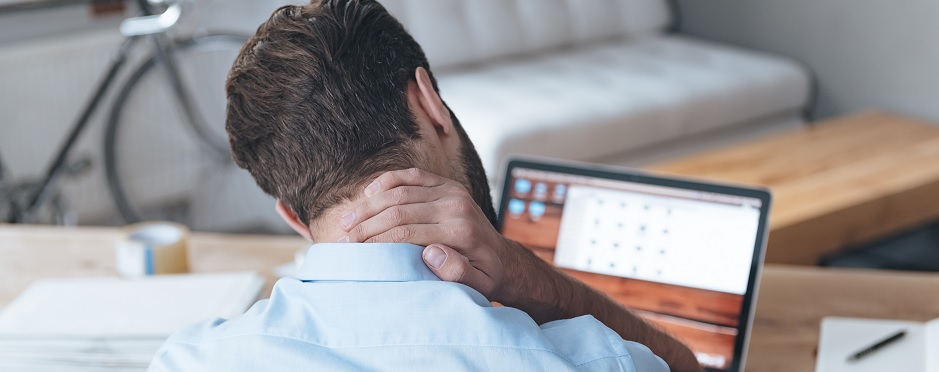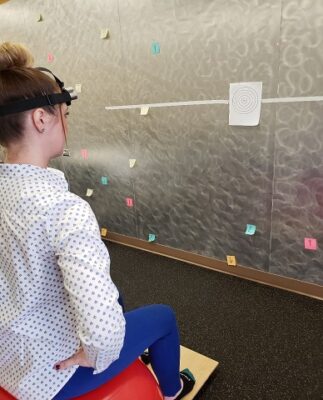
How Can A Laser Help with Neck Pain?
1 CommentThere are a lot of different ways to provide treatment for people dealing with headaches, neck pain, jaw issues, symptoms related to whiplash following a motor vehicle accident, or dizziness; however, when guided by a physical therapist treatment is often supported by research as well as the therapist’s experience. One unique technique to address many of these issues uses a cervical laser headlamp to retrain how you balance your head and neck in space. It often feels like a game which can make therapy more fun and interesting. It also offers patients immediate feedback. But how and why does it work? Let’s explore.
There are four systems that are influenced by this single activity alone. We need them all working together to decrease stress and strain to our posture, including our heads and necks.
- The first system is muscle spindles. They are tiny parts of each muscle fiber that takes information from nearby skin and joints to assist in communication with the control center, or the brain. This information helps the brain know where your head and neck are located in space and can adjust muscle tightness in response to the information. We do know there are a lot more of these spindles in the neck contributing to balancing our big heads on our shoulders.
- There are similar communicators, or receptors, in your joints as well. These work together with your muscles to tell your brain where your head and neck are located in space, and they work a little more at the end ranges of your movements to provide more information.
- The third system is the vestibular system. This is your balance center. It communicates the movement of your head in regards to speed and direction. This balance center works with your eyes, muscles, joints and brain to keep you upright even when you are turning your head to scan your environment. This system is also reinforced by certain reflexes that help you keep your vision stable while you move your head in space as well as keeping your body upright while you move.
- The final system is your ultimate control center and pathways – your spinal cord and brain. All of this information is sent through the spinal cord to your brain, where it helps figure everything out to keep you on your feet.
The laser technique has a lot of potential to help retrain these systems, your overall posture and balance. But lasers are also being used more around other joints to improve these systems working together for retraining post-surgery or in relation to improving sport performance. Evidence has shown that this treatment technique benefits all ages and genders, but an ability to improve may be impacted by those individuals who are hypermobile either congenitally or due to an injury or by fatigue.1
Your therapist will have you place the laser on your head and will align the target with where your natural head and position should be (it is fit to each individual person). You will start with the laser in the center of the target, close your eyes, turn your head– for instance to the right, and then bring it back to where you think the center is and open your eyes. Based on evidence, to see these systems are working well together, you will land in the center rings or even the middle circle.1 Anything outside of that indicates a need to relearn where your head and neck should be in space. But lucky for each of us, we are all capable of learning at any stage of life. There are also a lot of ways to make this more challenging as you progress toward your individualized goals and there are even ways a therapist could help you set this up to try at home.

Overall, if you are having any pain in your neck, head or jaw, or dizziness, please consider contacting Athletico Physical Therapy for a free assessment. Our therapists can take a look at your condition and provide recommendations for treatment, which may include retraining of your head/neck in space with a target and laser. Free assessments are available in-clinic and virtually through our Telehealth platform.
Physical therapy is usually the thing you are told to do after medication, x-rays or surgery. The best way to fix your pain is to start where you normally finish – with physical therapy at Athletico.
The Athletico blog is an educational resource written by Athletico employees. Athletico bloggers are licensed professionals who abide by the code of ethics outlined by their respective professional associations. The content published in blog posts represents the opinion of the individual author based on their expertise and experience. The content provided in this blog is for informational purposes only, does not constitute medical advice and should not be relied on for making personal health decisions.
References:
1. Armstrong, B., Mcnair, P., & Taylor, D. (2008). Head and Neck Position Sense. Sports Medicine, 38(2), 101–117. doi: 10.2165/00007256-200838020-00002

1 Comment
Henrik
Very informative thank you